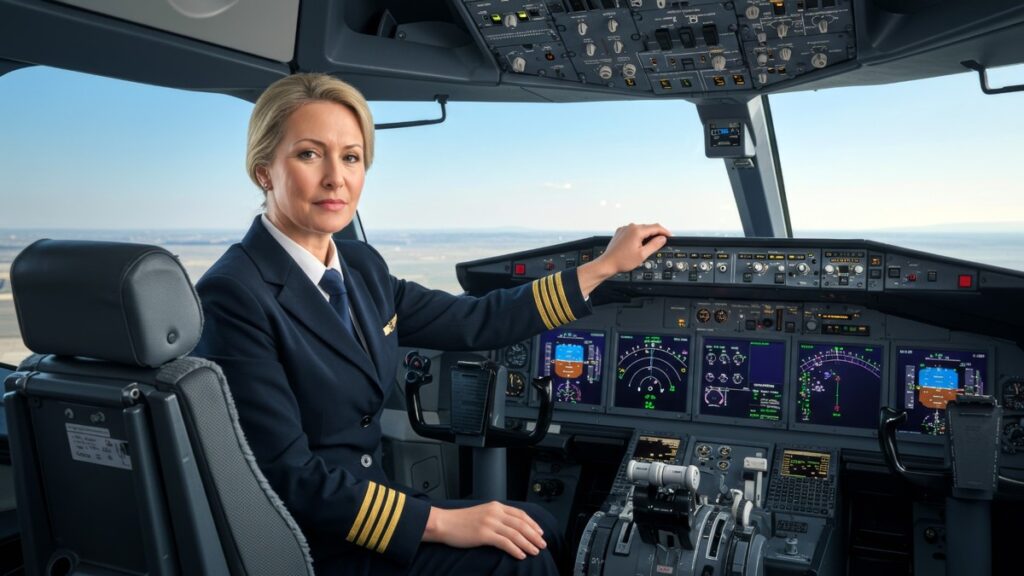Pilot Salary in India Per Month: The #1 Ultimate Guide

What is the Pilot Salary in India Per Month
Pilot salary in India per month is the number every aspiring pilots wants to know before investing lakhs in flight training.
It is a fair question. You are about to spend ₹25 lakh to ₹50 lakh and two years of your life learning to fly. You deserve to know if the paycheck at the end of it is worth it.
The answer depends on where you work and what you fly. A first officer at a regional carrier earns differently from a captain commanding wide-body aircraft for Air India. Domestic pilots make less than those flying international routes. The airline you work for, whether it is IndiGo, Air India, Vistara, or a cargo operator, can change your monthly income by several lakh rupees.
This guide reveals the complete breakdown of what pilots in India earn each month, how salaries differ across airlines, and what factors push income from ₹1.5 lakh to ₹8 lakh or more.
If you are training to become a pilot or thinking about whether this career is worth the investment, here is exactly what your monthly paycheck could look like.

What Is the Role of a Pilot
Before looking at the pilot salary in India per month, it is important to understand what pilots actually do. The job goes far beyond sitting in the cockpit and steering an aircraft. Pilots are responsible for every aspect of a flight, from planning the route to ensuring passenger safety in the air and on the ground.
A pilot’s main duty is to operate an aircraft safely. They study flight plans, weather reports, and navigation routes before every takeoff. During the flight, they monitor instruments, manage fuel levels, communicate with air traffic control, and handle any technical or environmental challenges that arise. Every decision made in the cockpit carries serious responsibility.
Pilots also follow strict schedules, maintain flight logs, and ensure the aircraft meets all safety and maintenance requirements. It is a mix of technical precision, discipline, and quick thinking under pressure.
In India, pilots work across several roles including:
- Commercial pilots who fly passenger aircraft for airlines like IndiGo, Air India, and Vistara
- Cargo pilots who transport freight for logistics companies and e-commerce carriers
- Charter and corporate pilots who operate private or business jets
- Flight instructors who train new pilots in flight schools
Every one of these roles contributes to the growth of Indian aviation and influences how much a pilot earns each month. The greater the experience, the higher the responsibility and the bigger the paycheck.
Pilot Salary in India Per Month (2025 Update)
The pilot salary in India per month depends on the type of pilot license, experience, and the airline you work for. Salaries have risen steadily in recent years due to India’s growing aviation sector and the global shortage of trained pilots. Airlines now compete for qualified crew, which has pushed monthly pay to record levels.
Average Monthly Pilot Salary in India (2025)
| Pilot Rank | Monthly Salary (INR) | Experience Level |
|---|---|---|
| Student Pilot (PPL Training) | ₹0 – ₹50,000 | In training and building flight hours |
| Commercial Pilot Trainee | ₹1,00,000 – ₹1,50,000 | Newly licensed and under supervision |
| First Officer | ₹2,00,000 – ₹4,00,000 | Co-pilot assisting captain on scheduled flights |
| Senior First Officer | ₹4,50,000 – ₹6,00,000 | Handling advanced operations with growing independence |
| Captain | ₹6,00,000 – ₹9,00,000 | Commanding aircraft and leading crew |
| Training Captain / Examiner | ₹9,00,000 – ₹12,00,000+ | Conducting training and evaluating pilots |
Figures are based on aviation industry salary reports and airline disclosures for 2025.
Pilot pay in India usually includes a base salary plus several allowances. These may include flight duty pay, layover benefits, and performance bonuses. For many pilots, these extras can raise total income by 30 to 50 percent above the base salary.
The variation in the pilot salary in India per month reflects different levels of experience, aircraft type, and route assignments. A captain flying international routes for a major airline earns much more than a regional pilot flying shorter domestic sectors. Over time, as experience builds, pay rises sharply and remains among the highest in professional careers.
Factors That Affect Pilot Salary in India Per Month
The pilot salary in India per month is not the same for every pilot. It changes with experience, rank, and even the routes you fly. Understanding these factors helps you see why two pilots with the same license can earn very different amounts.
Type of Aircraft Flown
Larger and more complex aircraft bring higher pay. Pilots flying wide-body jets such as the Boeing 787 or Airbus A350 earn significantly more than those operating smaller aircraft like the A320. The bigger the aircraft, the greater the responsibility and the higher the income.
Total Flight Hours
Experience is the most powerful driver of salary growth. Airlines place great value on total logged hours because they prove both skill and reliability. Pilots with higher hours are prioritized for upgrades, international routes, and training roles — all of which increase monthly pay.
Route Type
Domestic and international routes offer different levels of income. International pilots receive higher pay because they spend more time away from base, operate longer flights, and receive additional layover and foreign duty allowances.
Airline or Employer
Each airline in India follows its own pay scale. Legacy and full-service carriers like Air India and Vistara pay slightly more than budget airlines but may offer slower upgrades. IndiGo, on the other hand, offers faster promotions and consistent flight schedules.
Rank and Command Position
Every promotion increases both responsibility and salary. Moving from First Officer to Senior First Officer or Captain brings a major jump in monthly income. Captains and Training Captains are paid the most because they carry full command of the aircraft and oversee safety, operations, and crew performance.
Additional Certifications and Type Ratings
Pilots who invest in additional type ratings or specialized training earn more. These certifications qualify them to fly multiple aircraft types and open doors to better-paying positions.
Each of these factors directly affects the pilot salary in India per month. The more experience you gain, the larger the aircraft you fly, and the stronger your performance record, the faster your income grows.

Salary Comparison by Airline in India (2025)
The pilot salary in India per month depends greatly on which airline you fly for. Each company has its own pay scale, fleet type, and route structure. The larger and more established the airline, the higher the pay and benefits tend to be.
Average Monthly Salary by Airline (2025)
| Airline | Monthly Salary (INR) | Highlights |
|---|---|---|
| IndiGo | ₹4,00,000 – ₹9,00,000 | Fast promotions, consistent flying hours, strong domestic network |
| Air India | ₹5,00,000 – ₹10,00,000 | International routes with high allowances and long-haul exposure |
| Vistara | ₹4,00,000 – ₹8,50,000 | Premium airline offering good balance between work and pay |
| Akasa Air | ₹3,50,000 – ₹6,00,000 | Expanding airline with strong career opportunities |
| SpiceJet | ₹2,50,000 – ₹5,00,000 | Lower pay but easier entry for new pilots |
| AirAsia India | ₹3,00,000 – ₹6,00,000 | Reliable pay structure and growing regional presence |
Figures are based on industry data and airline disclosures for 2025.
The gap in the pilot salary in India per month reflects each airline’s business model and scale. Full-service airlines such as Air India and Vistara generally pay more because they operate international routes and wide-body aircraft. Budget airlines like IndiGo or Akasa Air offer faster promotions and more frequent flying hours, which can even out overall annual income.
Salary is important, but stability and growth matter more. IndiGo remains the most popular choice among Indian pilots because it combines solid pay, predictable schedules, and fast upgrades.
Air India provides higher pay potential for those aiming to fly long-haul routes. For younger pilots, new airlines like Akasa Air offer a chance to move up faster as fleets expand.
Pilot Salary Growth Over the Years
The pilot salary in India per month has changed dramatically over the past two decades. From a time when flying was a niche profession to today, where airlines compete to hire and retain skilled pilots, the pay scale has climbed at a steady pace.
Timeline of Pilot Salary Growth in India
| Year | Average Monthly Salary (INR) | Industry Context |
|---|---|---|
| 2005 | ₹1,00,000 – ₹2,50,000 | Aviation industry just beginning to expand, limited airlines and routes |
| 2010 | ₹2,50,000 – ₹4,00,000 | Private airlines enter the market, more domestic opportunities |
| 2015 | ₹3,50,000 – ₹6,00,000 | Fleet expansion across IndiGo, SpiceJet, and Jet Airways |
| 2020 | ₹4,00,000 – ₹7,50,000 | Post-pandemic recovery begins, pilot shortage starts building globally |
| 2025 | ₹5,00,000 – ₹9,00,000 | High demand, new airlines like Akasa Air, and record fleet orders |
The rise in pilot salary in India per month is linked directly to market demand. More passengers are flying, airlines are expanding fleets, and the number of trained pilots has not kept up. This shortage has created leverage for pilots, pushing salaries higher every year.
After the pandemic, many senior pilots retired or moved abroad, leaving a gap in the workforce. Indian airlines began offering faster promotions, signing bonuses, and better benefits to attract new talent. Salaries jumped almost 20 to 30 percent between 2021 and 2024 alone.
The trend is still upward. With new airports, more routes, and government initiatives like UDAN connecting smaller cities, the aviation market will continue to grow. For anyone entering flight training now, the next decade promises both career stability and strong earning potential.
Perks and Benefits Beyond Pilot Salary in India Per Month
The pilot salary in India per month is impressive on its own, but what makes the profession truly rewarding are the additional perks that come with it. Pilots enjoy financial, professional, and lifestyle benefits that few other careers can match.
Main Perks and Benefits
- Flight Duty Allowances that increase income with every hour flown
- Free or discounted travel for pilots and their families on domestic and international routes
- Medical and insurance coverage including loss of license protection
- Accommodation and layover benefits during overnight or long-haul assignments
- Retirement and provident fund contributions for long-term financial security
- Training and professional development programs that keep pilots current and certified
Allowances and benefits can add up to almost half of a pilot’s total income. Flight duty allowances reward active flying, while international layovers often include premium accommodation and meal expenses. For many pilots, these perks make a major difference in their overall earnings.
The aviation industry understands the physical and mental demands of flying. Airlines invest heavily in pilot wellness, health insurance, and fatigue management programs. This ensures safety in the air and stability on the ground.
Beyond financial benefits, pilots enjoy a lifestyle that blends work, travel, and personal growth. Every flight adds to experience, every route builds confidence, and every promotion brings higher pay and stronger rewards.
Career Progression Timeline
The pilot salary in India per month grows steadily with each step of a pilot’s career. Progression in aviation is not random; it follows a structured path built on skill, hours, and experience. Every upgrade in rank brings higher pay, more responsibility, and greater respect in the industry.
Here’s how a typical pilot’s career in India progresses from student to captain.
Student Pilot (PPL Training Stage)
This is the starting point for every pilot. During this stage, the focus is on basic flight skills and building the first 40 to 60 flying hours needed for a Private Pilot License (PPL). There is no real salary yet, but this stage builds the foundation for professional flying.
Commercial Pilot Trainee
Once a pilot earns a Commercial Pilot License (CPL), they begin structured training with an airline or flight school. Monthly earnings are usually around ₹1,00,000 to ₹1,50,000. The goal here is to log flight hours, gain confidence, and qualify for the right seat as a co-pilot.
First Officer
As a first officer, the pilot works alongside the captain and assists in all phases of flight. Salaries at this stage average between ₹2,00,000 and ₹4,00,000 per month. This period is about mastering flight procedures, communication, and teamwork.
Senior First Officer
After building several hundred hours and showing strong performance, pilots are promoted to senior first officer. They handle takeoffs, landings, and more complex operations. Monthly pay typically ranges from ₹4,50,000 to ₹6,00,000. This is where a pilot’s experience starts translating into real earning power.
Captain
Captains are in full command of the aircraft and responsible for every decision made during flight. This position comes with both high pressure and high reward. Monthly salaries range between ₹6,00,000 and ₹9,00,000. Captains also lead crew teams, manage emergencies, and ensure operational efficiency.
Training Captain or Examiner
At the top of the career ladder are training captains and examiners. They not only fly but also train and evaluate other pilots. Salaries at this level can exceed ₹12,00,000 per month depending on the airline. It is a position that combines leadership, technical expertise, and teaching skill.
Every step in this timeline builds toward mastery and financial growth. The faster a pilot gains experience and completes type ratings, the quicker they move up. The pilot salary in India per month reflects not just flight hours but also dedication, professionalism, and long-term commitment to safety and performance.

Challenges That Can Affect Income
While the pilot salary in India per month looks impressive, several factors can affect how much a pilot actually earns. Some challenges are within a pilot’s control, while others come from market conditions, airline policies, or regulatory changes. Understanding these helps new pilots plan realistically and avoid financial surprises.
Flight Hour Limitations
The biggest factor that directly impacts income is the number of flight hours. Pilots are paid per hour of flying, and weather conditions, maintenance delays, or scheduling issues can reduce total hours for the month. Fewer hours mean a smaller paycheck, even though the base salary stays the same.
Delays in Training or License Conversion
Becoming a pilot is a long process, and any delay in training or document approvals from DGCA can slow income growth. Many new pilots spend months waiting for type rating or airline joining, which postpones their first real paycheck. These gaps can temporarily affect the pilot salary in India per month during the early career stage.
Health and Medical Fitness
Pilots must maintain strict medical fitness to keep their license valid. A medical issue or loss of fitness can ground a pilot and stop income temporarily. This is why airlines offer loss-of-license insurance to protect against sudden income interruptions.
Economic and Industry Fluctuations
Aviation is sensitive to fuel prices, government policies, and travel demand. Economic downturns or global events like pandemics can lead to temporary pay cuts or reduced flying hours. While the pilot salary in India per month is usually stable, external market forces can cause short-term fluctuations.
Airline Restructuring and Route Changes
When airlines reorganize routes, open new bases, or close old ones, pilots may face schedule adjustments that affect their total pay. Changing from international to domestic routes, for instance, can reduce allowances and overall income.
Seniority and Competition
The aviation industry operates on seniority. Pilots who join earlier and stay longer secure faster promotions and better pay. High competition among new graduates can slow early career growth, which impacts how quickly the pilot salary in India per month increases.
Challenges exist in every profession, but aviation rewards consistency and professionalism. Pilots who stay current with training, maintain medical fitness, and build hours steadily experience strong long-term income growth. Despite short-term ups and downs, the pilot salary in India per month continues to rise year after year, driven by constant demand and industry expansion.
Final Thought
The pilot salary in India per month is more than a paycheck. It represents years of training, dedication, and the responsibility of carrying lives safely through the sky. Every pilot’s journey begins with long hours of study, strict medical tests, and countless flights that build skill and confidence. The reward is a career that pays well and commands respect.
As India’s aviation industry grows, so do the opportunities. New airlines, expanded routes, and modern fleets have turned flying into one of the most promising professions in the country. Pilots who stay committed to learning and remain disciplined in their craft see their monthly income rise steadily year after year.
The pilot salary in India per month will continue to climb as demand outpaces supply. For those willing to invest the time and effort, the financial and personal rewards are unmatched. Flying is not just a job; it is a lifetime achievement measured not only in rupees but also in purpose and pride.
Frequently Asked Questions About Pilot Salary in India Per Month
What is the pilot salary in India per month?
The pilot salary in India per month ranges between ₹1.5 lakh and ₹9 lakh, depending on rank, experience, and airline. Captains at major airlines can earn even higher with allowances and bonuses, while trainees start lower as they build hours and experience.
What is the starting salary of a pilot in India per month?
A newly licensed commercial pilot usually earns between ₹1 lakh and ₹1.5 lakh per month during initial training or probation. Once they become First Officers, the pilot salary in India per month can increase to ₹2 lakh or more.
Which airline pays the highest pilot salary in India?
Air India and Vistara are among the top-paying airlines in India. Captains on international routes can earn up to ₹10 lakh or more per month, while pilots at IndiGo and Akasa Air earn slightly lower but enjoy faster promotions and stable flying hours.
Do pilots in India get paid during training?
No. Student pilots do not earn a salary during flight training. Income begins only after completing the Commercial Pilot License and joining an airline as a trainee or First Officer.
How much does a captain earn in India per month?
A captain’s pilot salary in India per month ranges from ₹6 lakh to ₹9 lakh, depending on the airline, aircraft type, and total flight hours. Captains flying international routes often earn the most due to additional allowances.
How fast can a pilot become a captain in India?
On average, it takes six to ten years for a pilot to move from trainee to captain. The timeline depends on flight hours, training quality, and airline requirements.
Do pilots get additional benefits besides salary?
Yes. In addition to the pilot salary in India per month, pilots receive flight duty allowances, travel privileges for family, medical coverage, housing during layovers, and retirement contributions. These perks can add 30 to 50 percent more to their total income.
Are pilot salaries in India increasing?
Yes. Pilot salaries have been rising steadily due to India’s growing aviation sector and the global pilot shortage. With more aircraft orders and route expansions, the pilot salary in India per month is expected to grow even higher in the coming years.
Contact the Florida Flyers Flight Academy India Team today at +91 (0) 1171 816622 to learn more about the Private Pilot Ground School Course.



